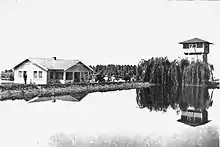Shafter Cotton Research Station
The Shafter Cotton Research Station is a California Historical Landmark in Shafter, California. The Research Station was built in 1922. The Shafter Cotton Research Station became a California State Historical Landmark No. 1022 on March 3, 1997. The Research Station is located at 717053 Shafter Avenue. The Shafter Cotton Research Station was built by the U.S. Department of Agriculture (USDA). The US Hatch Act of 1887 provided US funding of agricultural science. The Shafter Cotton Research Station was built to provide California with high quality cotton
| Shafter Cotton Research Station | |
|---|---|
 Shafter Cotton Research Station in 1922 | |
| Location | 17053 Shafter Avenue, Shafter, Kern County, California |
| Coordinates | 35.53245°N 119.278067°W |
| Built | 1922 |
| Official name | Shafter Cotton Research Station |
| Designated | March 3, 1997 |
| Reference no. | 1022 [1] |
The first director was W. B. Camp, who moved to California from South Carolina in 1917. Camp studied agronomy at Clemson University and also worked at USDA Cotton Breeding Office. Camp with the USDA worked to come up with strong Cotton fabric to be used World War I plane wings. Camp and Shafter Cotton Research Station worked with Egyptian Pima Cotton and later Acala #8 cotton, named after Acala, Texas.
Shafter Cotton Research Station change from a USDA Research Station to a private on in June 2012. The San Joaquin Valley Quality Cotton Growers Association now runs the facility. With this change, the Shafter Research Station now works other crops including orchard crops. Today the facility a 20-acre campus, 20 buildings and 60 acres of experimental crops.[2]
- California State Historical Landmark reads:
- NO. 1022 SHAFTER COTTON RESEARCH STATION - The Shafter Cotton Research Station, established here in 1922 by the U.S. Department of Agriculture, developed the "Acala" varieties which were exceptionally well suited to the San Joaquin valley. The quality of the acala cottons and the marketing advantage of the one variety cotton district, created in 1925, resulted in premium cottons with a world-wide demand. Through the continued vision and cooperative efforts of growers and researchers, production of acala cotton became one of California's largest agricultural enterprises. [3]
References
- "hafter Cotton Research Station". Office of Historic Preservation, California State Parks. Retrieved 2012-10-07.
- Valley Ag Voice, The Shafter Cotton Research Station: 97 Years of Innovation, December 1, 2020, by Mike McCoy
- californiahistoricallandmarks.com # 1022